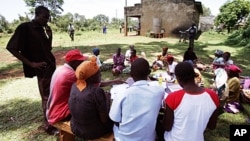A new report in the medical journal The Lancet shows a sharp decline in child mortality rates in 14 African villages taking part in the U.N.-backed Millennium Village Project. Project officials say the findings are evidence that tackling several development goals at the same time using simple, low-cost solutions is vital for successful development.
In the Millennium Village of Sauri in western Kenya, about 80 babies out of 1,000 die within the first month after they are born. That number may seem high, but six years ago, up to 140 babies out of 1,000 might not live past their first month.
James Wariero is regional health systems advisor at Millennium Development Goals Center, East and Southern Africa. He describes one of several initiatives that the Sauri community has taken to cut down on the babies' deaths.
"We use a mobile telephony for a public health program that we started called 'Child Count Plus,' through which community health workers track mothers who are pregnant, and track the antenatal visits that they take, and know the expected date of delivery. That way, you try to prevent this problem of delays by ensuring that these mothers are referred early enough for delivery, and that they are accompanied sometimes by the community health workers," said Wariero.
Sauri is one of 14 so-called "Millennium Villages" in 10 countries across Africa, a project that began in 2006 to show how communities could implement the United Nations' eight Millennium Development Goals. These goals include: cutting extreme poverty and hunger in half; ensuring that children everywhere get free primary education; and reducing by two-thirds the under-five mortality rate.
Economist and professor Jeffrey Sachs is founder of the Millennium Villages Project. Sachs says that each community works on improving their agriculture, health care, education, infrastructure and business development, simultaneously.
"In each of the Millennium Villages there is a small team that has somebody responsible for each one of those sectors," said Sachs. "The team works together to bring improved technologies and strategies to bear in these areas."
His initiative is starting to show results. This week, the medical journal The Lancet published a study that found death rates for children under five declined 22 percent on average across nine Millennium Villages in the first three years of their operation. When compared with similar communities in the 10 countries, the decline was 32 percent.
"Malaria control surely has played an enormous role in this reduction of child mortality. One of the first steps in the Millennium Villages is to ensure that every sleeping site in every household has an anti-malaria bed net, that is a bed net treated with insecticide to protect against bites from the malaria-carrying mosquitoes," added Sachs.
Also contributing to the decline in child mortality were front-line malaria medicines, improved nutrition, the delivery of oral rehydration solutions in diarrhea cases, and immunization against pneumonia.
Regional health systems advisor Wariero says members of the Sauri village are continually looking at ways to improve their health care and other programs. He says one measure is the so-called "verbal autopsy," where a trained health-care worker armed with a smartphone visits the homes of children who died.
"We are trying to see the clinical causes of death, but also try to see the social causes of death: the delays, whether there was a lack of money, a lack of transport, whether there was belief in cultural things that may have prevented them from seeking care earlier," said Wariero.
He says the information collected helps health care workers to spot any trends and modify or implement new programs to prevent child deaths.
Founder Sachs says that the Millennium Villages Project also shows that not much money is needed to significantly lift up a community's living standards. He says that, in the first three years of the project, total spending for each villager in the 14 Millennium Villages was $115 per person - not a lot, he says, to develop health care, education, agriculture, business, and infrastructure.
"But small amounts of money can go a long way in very impoverished settings by helping people who have almost nothing to be able to gain access to these critical technologies, life-saving medicines or prevention techniques like the bed nets or to build new classrooms for their children," noted Sachs.
The Millennium Villages Project is led by the Earth Institute at Columbia University in New York, the United Nations Development Program and the New York-based non-profit organization Millennium Promise.
Millennium Villages Shown to Cut Child Mortality





